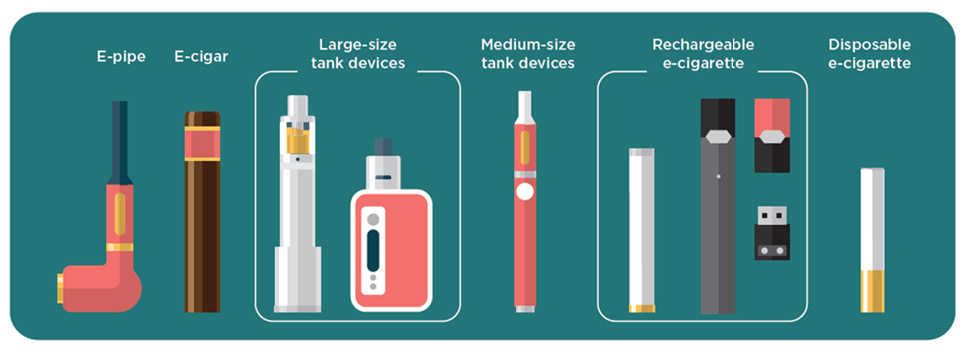Vaping Prevention
What Are E-cigarettes?
- E-cigarettes are electronic devices that heat a liquid and produce an aerosol, or mix of small particles in the air.
- E-cigarettes come in many shapes and sizes. Most have a battery, a heating element, and a place to hold a liquid.
- Some e-cigarettes look like regular cigarettes, cigars, or pipes. Some look like USB flash drives, pens, and other everyday items. Larger devices such as tank systems, or “mods,” do not look like other tobacco products.
- E-cigarettes are known by many different names. They are sometimes called “e-cigs,” “e-hookahs,” “mods,” “vape pens,” “vapes,” “tank systems,” and “electronic nicotine delivery systems (ENDS).”
- Using an e-cigarette is sometimes called “vaping” or “JUULing.”
What Are the Other Risks of E-cigarettes for Kids, Teens, and Young Adults?
- Scientists are still learning about the long-term health effects of e-cigarettes.
- Some of the ingredients in e-cigarette aerosol could also be harmful to the lungs in the long-term. For example, some e-cigarette flavorings may be safe to eat but not to inhale because the gut can process more substances than the lungs.
- Defective e-cigarette batteries have caused some fires and explosions, a few of which have resulted in serious injuries.
- Children and adults have been poisoned by swallowing, breathing, or absorbing e-cigarette liquid through their skin or eyes. Nationally, approximately 50% of calls to poison control centers for e-cigarettes are for kids 5 years of age or younger.
Did You Know?
e-cigarette/vaping product use associated lung injury (EVALI) cases have been reported to CDC as of October 8, 2019
Notice Vaping
The Epidemic!
Can Using E-cigarettes Lead to Future Cigarette Smoking Among Kids, Teens, and Young Adults?
Many young people who use e-cigarettes also smoke cigarettes. There is some evidence that young people who use e-cigarettes may be more likely to smoke cigarettes in the future. Specifically, a 2018 National Academy of Medicine report found that there was some evidence that e-cigarette use increases the frequency and amount of cigarette smoking in the future. E-cigarettes also can be used to deliver other drugs, including marijuana; in 2016, approximately one-third of U.S. middle and high school students who have ever used an e-cigarette reported using marijuana in the device. But e-cigarette use among young people is unsafe, even if they do not progress to future cigarette smoking.

Tobacco Prevention
Tobacco use by youth and young adults causes both immediate and long-term damage. One of the most serious health effects is nicotine addiction, which prolongs tobacco use and can lead to severe health consequences. The younger youth are when they start using tobacco, the more likely they’ll be addicted.
- Early cardiovascular damage is seen in most young smokers; those most sensitive die very young.
- Smoking reduces lung function and stunts lung growth. Teens who smoke are not only short of breath today, they may end up as adults with lungs that will never grow to full capacity. Such damage is permanent and increases the risk of chronic obstructive pulmonary disease.
- Youth are sensitive to nicotine and can feel dependent earlier than adults. Because of nicotine addiction, about three out of four teen smokers end up smoking into adulthood, even if they intend to quit after a few years.
- Among youth who persist in smoking, a third will die prematurely from smoking.
Smoking leads to disease and disability and harms nearly every organ of the body.
More than 16 million Americans are living with a disease caused by smoking. For every person who dies because of smoking, at least 30 people live with a serious smoking-related illness. Smoking causes cancer, heart disease, stroke, lung diseases, diabetes, and chronic obstructive pulmonary disease (COPD), which includes emphysema and chronic bronchitis. Smoking also increases risk for tuberculosis, certain eye diseases, and problems of the immune system, including rheumatoid arthritis.
Secondhand smoke exposure contributes to approximately 41,000 deaths among nonsmoking adults and 400 deaths in infants each year. Secondhand smoke causes stroke, lung cancer, and coronary heart disease in adults. Children who are exposed to secondhand smoke are at increased risk for sudden infant death syndrome, acute respiratory infections, middle ear disease, more severe asthma, respiratory symptoms, and slowed lung growth.
What Can I Do to Prevent My Child from Using E-cigarettes or to Help Them Stop?
- Set a good example by being tobacco-free and ensure that your kid is not exposed to the secondhand emissions from any tobacco products, including e-cigarettes.
- If you use tobacco, it’s never too late to quit. For free help, visit smokefree.gov or call 1-800-QUIT-NOW.
- Talk to your child or teen about why e-cigarettes are harmful for them. It’s never too late.
- Get the Talk With Your Teen About E-cigarettes tip sheet for parents. Start the conversation early with children about why e-cigarettes are harmful for them.
- Let your child know that you want them to stay away from all tobacco products, including e-cigarettes, because they are not safe for them. Seek help and get involved.
- Set up an appointment with your child’s health care provider so that they can hear from a medical professional about the health risks of tobacco products, including e-cigarettes.
- Speak with your child’s teacher and school administrator about enforcement of tobacco-free school grounds policies and tobacco prevention curriculum.
- Encourage your child to learn the facts and get tips for quitting tobacco products at teen.smokefree.gov.
SOURCES:
Center for Disease Control
US Department of Health and Human Services
%
of adult daily smokers started smoking by the age of 18
youth under 18 smoke their first cigarette!
Substance Abuse Council
Contact Us

34 West Jackson Street, Suite 2A
Battle Creek, MI 49017
269-326-4040
Helpful Links
© Substance Abuse Council | Designed by GreenStreet Marketing
![VapingWebsiteHeader[1]](https://www.drugfreebc.org/wp-content/uploads/2020/09/VapingWebsiteHeader1.jpg)
